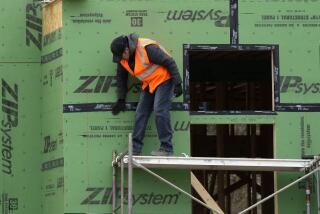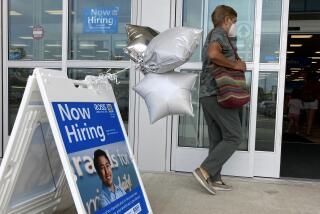U.S. Productivity Dips; Experts Say Figure Is Volatile : Economy: Economists attribute drop mainly to recent surge in hiring. Decline also raises specter of inflation.
- Share via
The productivity of American workers fell for the first time in more than a year during the spring, the federal government reported Tuesday, and economists attributed the decline mainly to a recent surge in hiring by U.S. employers.
Preliminary figures showed that productivity dropped at an annual rate of 1.2% from April through June. At the same time, a measure of employment--hours worked by everyone in the labor force--climbed 5.4% during the second quarter, the biggest gain since 1988.
Productivity is a measure of business efficiency, reflecting the output per hour of work of all employees. It is an important economic gauge over the long term because, among other things, it helps determine a nation’s standard of living and the competitiveness of its products in foreign markets.
Declining productivity also raises the specter of renewed inflation. But those concerns were largely offset by additional second-quarter figures showing a skimpy 0.8% rise in hourly compensation, the smallest advance in six years.
Taking all of the figures into account, many analysts said the decline in productivity was not alarming and that it was characteristic of an economy moving into a later phase of recovery. Earlier in the recovery, these analysts explained, companies found ways to boost productivity by squeezing more out of their existing staff and equipment while waiting to see if the recovery would last.
Now, in many cases, employers “have pushed their resources to the limit, so they have to hire more,” said Lynn Reaser, chief economist with First Interstate Bancorp in Los Angeles.
Meanwhile, the productivity per worker at these firms is likely to slump at least until the recent hires are fully trained and their performance is brought up to par with veteran employees.
Another possible explanation for lower productivity is that workers at “lean and mean” companies who for months or even years have put in long hours may be starting to burn out. Likewise, employers that have delayed investing in new equipment are now suffering some of the consequences.
Analysts cautioned that the productivity figures are volatile and are likely to be revised when updated statistics are released next month.
In fact, economist Robert A. Brusca of Nikko Securities in New York speculated that productivity is actually much better than Tuesday’s numbers suggest. He pointed to the heavy capital investments and continued staff cutbacks by major companies, actions believed by many executives to be boosting their firms’ productivity.
“You’ve got to ask yourself whether all these people are wrong,” Brusca said.
In addition, productivity is still up 2.6% over the past year.
But Brusca warned that if productivity goes into a genuine slump, it is likely to fuel inflation. Rising productivity ordinarily keeps inflation in check by providing savings to offset the higher wages that typically come during an economic recovery.
The nation’s last previous decline in productivity was a 1.8% drop in the first quarter of 1993.
In a separate economic report, the government reported that wholesale sales rose in June for a second straight month and inventories of unsold goods fell. Sales by wholesalers were up 0.5% to a seasonally adjusted $168.7 billion, following a 0.3% increase in May.
Inventories dropped in June by 0.4% to a seasonally adjusted $222.3 billion after rising 1.6% in May and 1% in April. That decline, Reaser said, eases concerns of a possible inventory surplus that could lead to sales and production cutbacks.
More to Read
Inside the business of entertainment
The Wide Shot brings you news, analysis and insights on everything from streaming wars to production — and what it all means for the future.
You may occasionally receive promotional content from the Los Angeles Times.









